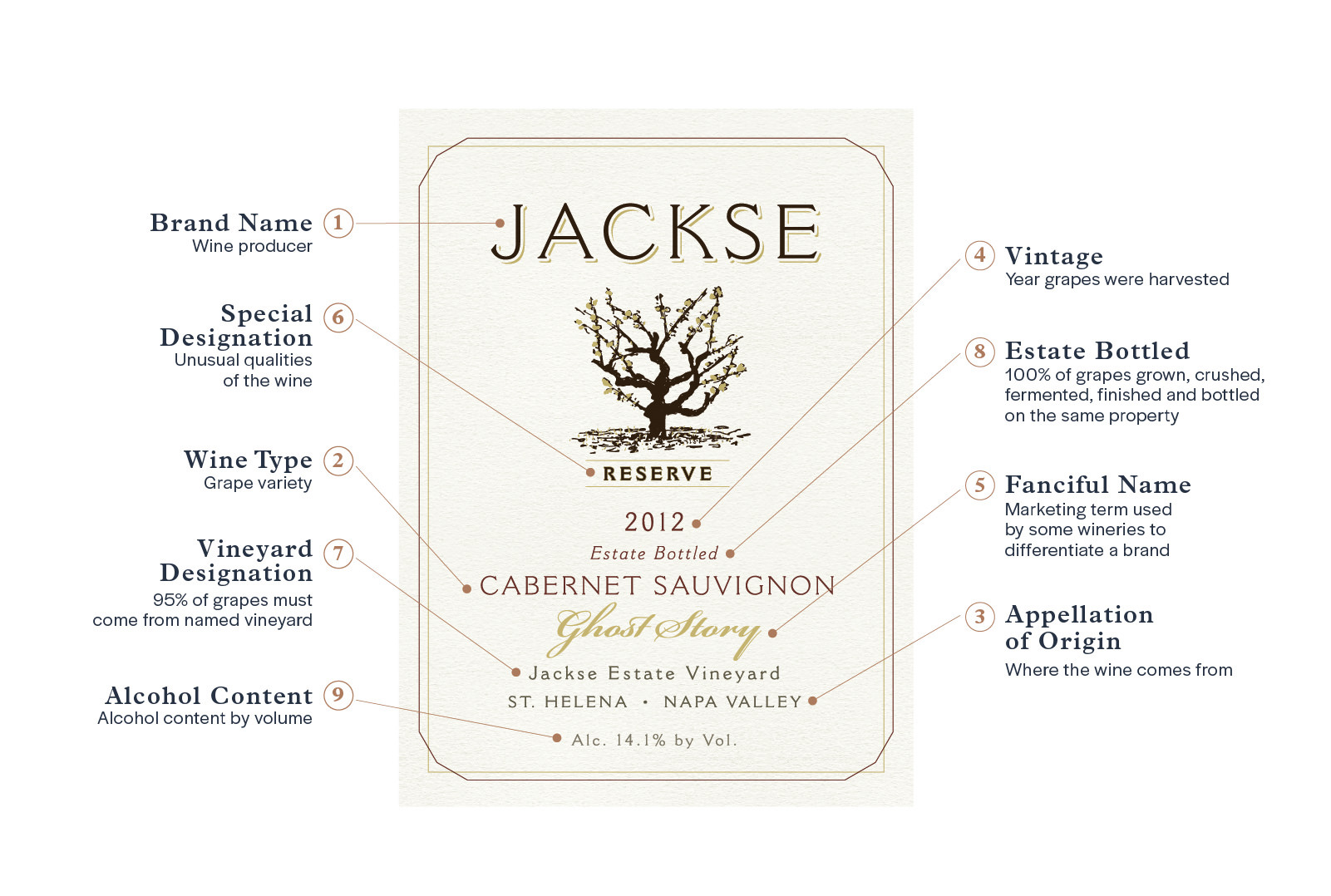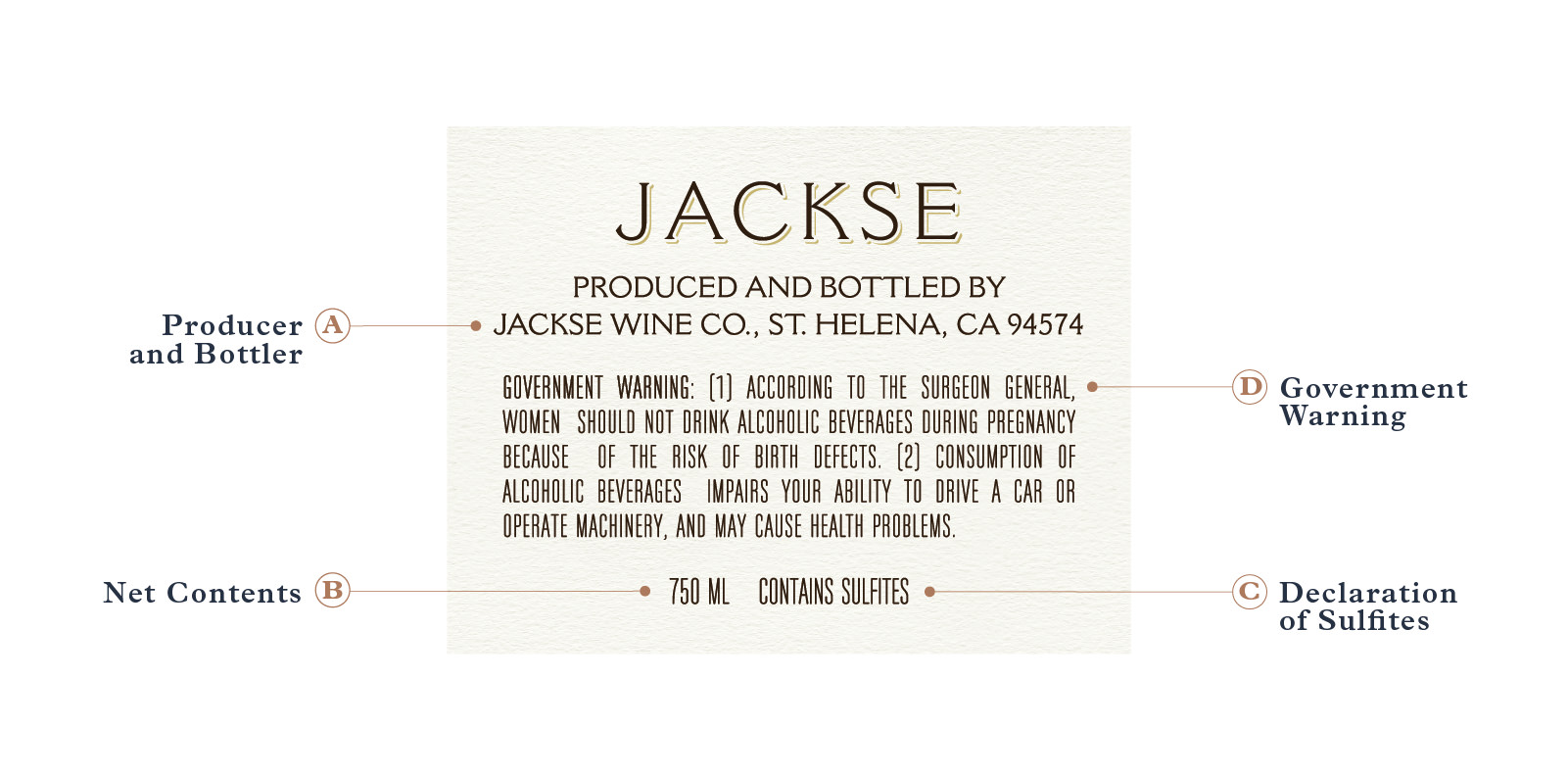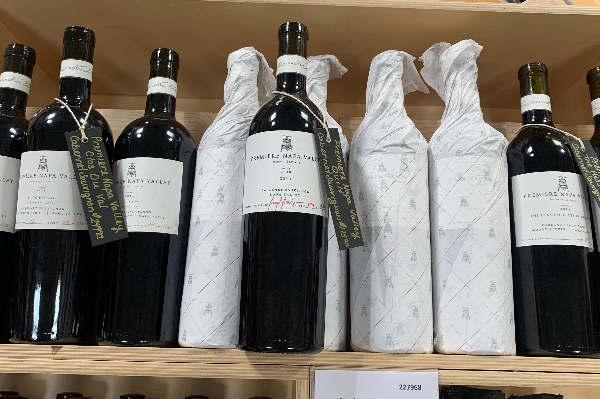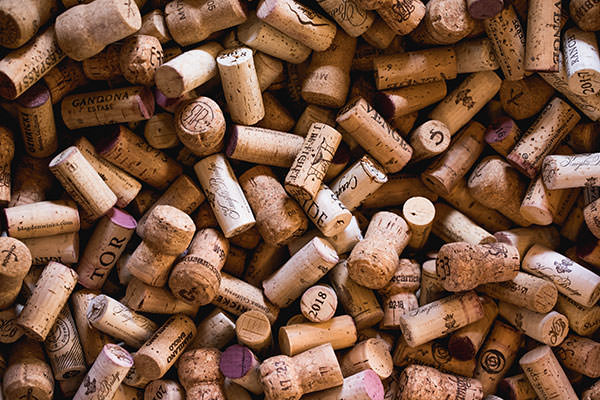Just walking into the retail wine section of a grocery store, wine shop or winery itself can be overwhelming. How do you differentiate or select bottles of wine? To answer, let's start with the very basic of basics …
What is the one thing that literally every bottle of wine in the world has in common? The label.
There is plenty of information on that little rectangle (in most cases 4½ by 3¼-inches). Most of it is required, some of it is optional.
Different countries have different standards for what information is required. In the United States, wine labels are regulated by the Alcohol and Tobacco Tax and Trade Bureau of the U.S. Treasury Department (often referred to as the TTB). Some states, such as California, have adopted supplemental labeling laws. Napa Valley wineries have historically provided more information than the minimum amount required by law.
Let's look at each priceless piece of information.
The Front Label - the one designed to catch your eye on a shelf!

To start, just a warning that some of this information can be a bit technical, so under many sections you will see at least one Helpful Tip that attempts to simplify or justify the jargon.
1 Brand Name — mandatory
This tells you who makes the wine. If you want a bottle of wine from Robert Mondavi Winery, don't grab one that says Trefethen Family Vineyards. And vice versa! — P.S. Both brands are great, like all Napa Valley wines (not that we're biased or anything).
If no brand name is on the label, the bottler's name (on the back label) is considered the brand. It is also useful to refer to the bottler's name if a winery has several brands.
2 Wine Type — mandatory
This tells you what you're drinking. If you're only worried if it's a red wine or a white wine, well, hold it up to the light and see what color it is … but even that can be deceiving if the color of the bottle itself isn't crystal clear. So, yeah, it's probably better to read what wine type—or variety—it is.
A wine may be labeled by a grape or variety name such as Chardonnay or Cabernet Sauvignon, or it may be given a generic name such as Red Wine. Wines using variety names must derive at least 75% of their volume from the grape designated, and the variety name must appear on the label with an appellation of origin (i.e., specific location where the grapes were grown).
Although not required, many wineries voluntarily list the proportions of the grape varieties that comprise their wine blends.
Helpful Tip: Most red wines are served at room temperature and tend to taste "heavier" or more "full." Most white wines are served chilled—not ice cold, more in the 65-degree range—and are generally considered more "refreshing."
3 Appellation of Origin — mandatory
While drinking wine is a very fun pastime, this may be the most serious portion of a wine label. An appellation is a legally defined and protected geographical indication used to identify where the grapes for a wine were grown.
Organizations like our very own Napa Valley Vintners have spent many years making sure that Napa Valley wines are protected from impostors and those that originate from outside county lines.
Wine labels may contain several types of geographic designations of origin:
- Appellations of origin that are the names of states and counties can be used on wine labels under federal law if at least 75% of the grapes come from the named state or county. The remainder of the grapes may come from outside the named state or county.
- For wine labeled with an American Viticultural Area (AVA), which is a specific type of appellation of origin established under federal law, at least 85% of the grapes must come from the named AVA (for example "Napa Valley"), while the remainder of the grapes may come from outside of the AVA. That wine must be fully finished in the state in which the AVA is located.
- California law requires that 100% of the grapes come from within California for any wine labeled with the appellation of origin California or a geographical subdivision of the state. This is stricter than the federal labeling standard.
4 Vintage — optional
Think of the vintage like you would think of the year your car was made. For example, if someone owns a 2014 Honda Civic, it means the car was made in 2014.
It's similar with wine—the vintage designates the year in which the grapes were harvested. (This is the start of the winemaking process—wines will be finished, bottled and released in a year different from the harvest year.)
Much like appellation of origin, vintage has some specific rules as well:
- As of May 2006, federal regulations allow that up to 15% of the blend can be from a vintage other than the stated year. The law was designed to allow American producers to be held to the same standards as other wine-producing countries.
- Previously, the U.S. standard required that 95% of the grapes in the bottle be from the stated vintage. This regulation only applies to wines that do not use an American Viticultural Area (AVA). For example, if the grape source is noted to be "California," 85% from the stated vintage is the applicable rule.
- AVA wines are held to a higher standard. For example, for wines labeled Napa Valley or one of its nested or sub-appellations, 95% of the grapes must be from the stated vintage. The vintage bears no relationship to when the wine was bottled.
Helpful Tip: Generally, grocery stores sell primarily current release wines, which is slightly confusing because the vintage is usually about two years behind the time it was released. If you venture into a wine shop or the tasting room of a winery itself, they tend to have a wider selection of previous vintages.
5 Fanciful Name — optional
This is a marketing term used by some wineries to differentiate "brands within a brand" … they can be named after anything ranging from specific vineyards where the grapes came from, to children of the owners, to pets of the owners, to stuff that rhymes or just sounds cool.
Meaning, a winery might have three to four different Cabernet Sauvignons released in the same year, so spend a couple of extra minutes reading the labels to make sure you know what you are buying.
Helpful Tip: If you get confused, default to the concept that all Napa Valley wines are good, and you won't be disappointed.
6 Special Designation — optional
Labels often contain special terms to indicate unusual qualities of the wine, such as degree of sweetness or color. Sometimes the wine is of such a high standard as to be designated by the winemaker as a special selection or private reserve.
Helpful Tip: Sometimes these wines cost more, but are revered for their quality.
7 Vineyard Designation — optional
Many wineries name the vineyard where the grapes were grown because the winery believes the property produces an unusually high-quality grape. The winery or an independent grower may own the vineyard. When using a vineyard designation on a wine label, federal regulations require that 95% of the grapes be grown in the named vineyard.
Helpful Tip: These, too, sometimes cost more due to the quality and reputation of the vineyard.
8 Estate Bottled — optional
This term certifies legally that the winery grew 100% of the grapes on land it owns or controls and that the winery crushed, fermented, finished, aged and bottled the wine in a continuous process on the same property. Both the vineyard and winery must be located in the viticultural area that is stated on the label.
Helpful Tip: Wineries are very excited about this and proud of it.
9 Alcohol Content — mandatory
This statement on a wine label indicates the alcohol content by volume.
The nitty-gritty details (warning, "math-y" things follow):
- There is a tolerance of plus or minus 1.5% if the wine has an alcohol content of 14% or less.
- A tolerance of plus or minus 1.0% is allowed if the wine has an alcohol content of more than 14%.
- However, the tolerance cannot be used to cross the 14% alcohol content threshold, which is the dividing line between two tax classes.
- So a wine that is actually 13.5% alcohol by volume could be labeled 12% or 14% but not above 14%.
- Finally, a wine that is 14% or less alcohol by volume can be labeled table wine without any notation of the numeric alcohol content.
Helpful Tip: The higher the alcohol content, the more you should pace yourself.
Helpful Tip #2: Most red wines have a higher alcohol content than white wines.
The Back Label

A Producer and Bottler — mandatory
This is Appellation of Origin's first cousin and gives a great deal of information about the production of the wine. The label must indicate the bottler and its location.
Several descriptions are common and it can be important to understand the differences between them:
- Produced and bottled by certifies that the bottler fermented 75% or more of the wine at the stated address (for example, "Produced and Bottled by ABC Winery, St. Helena, California"). In combination with other information on the label, such as a vineyard designation, this term provides the consumer with significant information about the origin of the wine and who is responsible for its production.
- Cellared and bottled by indicates that the bottler has subjected the wine to cellar treatment before bottling at the stated address.
- Made and bottled by indicates that the bottler fermented at least 75% of the wine at the stated address.
- Bottled by indicates that the winery bottled the wine at the stated address, which may have been grown, crushed, fermented, finished and aged by someone else at some other address.
B Net Contents — mandatory
The fluid volume in metric measurement must be indicated on the label or be blown into the glass.
Helpful Tip: When someone says "bottle of wine" they are talking about a 750mL format. The next most common sizes are half bottles (375mL) or magnums (1.5L, which is twice as much as 750mL—basically two bottles of wine).
C Declaration of Sulfites — mandatory
Wines which have a level of 10 parts per million or greater of sulfur dioxide must be labeled with a sulfite declaration (i.e., "Contains Sulfites").
Helpful Tip: No need to worry about this unless you are allergic to sulfites (they can give a headache).
D Government Warning — mandatory
All wine bottled after November 18, 1989 must bear the health warning statement in the exact manner and wording specified in the federal regulations.
If you are still reading this, thank you … and enjoy your next bottle of wine, armed with the knowledge that you know why all this stuff is crammed onto the wine's label!




